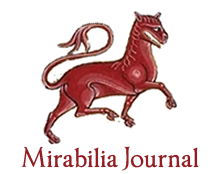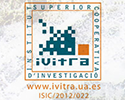The Kingdom of the Spirit in the transcendence of the image of Christ. The Good Shepherd in Early Christian Art (3rd-4th centuries)
Armando Alexandre dos SANTOS; Ricardo da COSTA
Original title: O Reino do Espírito na transcendência da imagem de Cristo. O Bom Pastor na Arte Paleocristã (sécs. III-IV)
Published in The Kingdom of the Spirit
Keywords: Good Shepherd, History of Art, Paleochristian Art, Sarcophagus.
The aim of the work is to analyze the iconographic theme of the Good Shepherd (Jo 10, 6-15) in Paleochristian Art (III-VI centuries) and the reasons for its popularity. Our methodology will be comparative: documents and images from the same period, with an interpretative emphasis on carved scenes in three Roman sarcophagi from the 3rd and 4th centuries.
The Knowledge that Beautifies the Soul. Philosophy according to Diotima of Mantinea, Herrad of Hohenbourg and Christine de Pizan
Georgina RABASSÓ
Original title: El saber que embellece el alma. La filosofía según Diotima de Mantinea, Herrada de Hohenbourg y Christine de Pizan
Published in The Medieval Aesthetics
Keywords: Beauty, Liberal Arts, Medieval Aesthetics, Medieval Philosophy, Wisdom, Women Philosophers.
Diotima of Mantinea’s arguments in Plato’s Symposium (5th century BC) and the writings of Herrad of Hohenbourg (c. 1125-c. 1195) and Christine de Pizan (1364-1430) show the deep influence the study of philosophy had on them, in varying ways. Analysis of texts (and certain images) in which these writers speak of their relationships with the discipline of philosophy evidences the importance they give to their intellectual work, knowledge and critical analysis, not only for themselves but also as a distinctive component of female beauty as narrated by women themselves. This ideological contribution was key to the genesis of concepts such as “merit”, “nobility” and “excellence”, terms through which the women thinkers of the querelle des femmes (14th-18th centuries) took on the auctoritates of the male gender, who had stipulated that the overriding, exclusive beauty of women was corporeal and, occasionally, spiritual.
The Latin Middle Ages and Nature: the image of the garden in the Roman de la Rose
Adriana MARTÍNEZ
Original title: El Medievo latino y la Naturaleza: la imagen del jardín en el Roman de la Rose
Published in The Medieval Aesthetics
Keywords: Garden, Middle Ages, Roman de la Rose.
The image of the garden, synecdoche of nature, which traverses the Latin middle ages is base don judeo-christian culture that makes the concept of Paradise. However, in the 12 th century a renewal is produced in thinking nature not only as a reality outside, inteligible, and in the following century, a text like the Roman de la Rose installed a concept of nature where the garden becomes privilegeg stage of love, a new Paradise.
The Love as the greatest virtue in the Sermons of Nicholas of Cusa
Maria Simone Marinho NOGUEIRA
Original title: O Amor como a maior das virtudes nos Sermões de Nicolau de Cusa
Published in Nicholas of Cusa in Dialogue
Keywords: Love, Nicholas of Cusa, Sermons, Virtue.
Nicholas of Cusa approached the theme of love throughout his philosophical-theological work. A part of this work, however, deserves our special attention when we analyze this theme. We refer to the Sermons: in various moments of his life the German Thinker has prepared and preached these writings. We propose, from them, a reflection on the love as the greatest of virtues.
The Metaphysical Foundations of Human Cloning
James A. MARCUM
Original title: Os Fundamentos Metafísicos da Clonagem Humana
Published in
Keywords: Holism – Human cloning – Methodological reductionism – Ontological reductionism – Reproductive technology.
The presuppositions upon which human reproductive cloning technology relies are examined, in order to address the debate over human uniqueness and identity, as well as dignity and flourishing. To that end, the presupposition of reductionism that animates the modern biomedical sciences is initially explored. As methodological reductionism, reductionism is important for conducting scientific research; but as ontological reductionism, it is often insufficient for interpreting the cultural or social meaning of scientific data. The distinction between methodological and ontological reductionism is necessary to address the debate surrounding reproductive cloning technology and human nature and flourishing. Scientists and others who depend upon empirical research would be better served by shifting from ontological reductionism to holism, when interpreting scientific data on human cloning in terms of their social meaning and impact on public policy.
The Music in Don Quijote by Miguel de Cervantes (1547-1616)
Antonia Javiera CABRERA MUÑOZ
Original title: La Música en el Don Quijote de Miguel de Cervantes (1547-1616)
Published in Music in Middle Ages and Early Modernity
Keywords: Don Quijote de la Mancha, Miguel de Cervantes, Music.
This article deals with Music in the great work Don Quixote de la Mancha (1605 and 1615), written by Miguel de Cervantes (1547-1615) during the Spanish Golden Age. In this relationship between the two Arts (Literature and Music) we emphasized the protagonist character of the work, Don Quixote de la Mancha, who, in both parts, gradually evolve his musical sense to see himself as a fully musical character in the second part: Music is present in various attitudes of his in several episodes, using the recitation and singing, instrumental, general knowledge and even dance to show their musical skills. Several authors have studied this relationship in detail, so that in this work we made a brief synthesis of some contents with the purpose of introducing the Brazilian reader to this relationship in Don Quixote, since in Brazil there is nothing published on the subject, as verified in the main research databases available to the general public and specialized. We begin with a brief synthesis of the life and work of Cervantes, highlighting his literary path to understand a little of his worldview as an intellectual; then we dedicate ourselves to his relationship with Music, the musical environment of his time and how the musical expression was introduced in his works; at once, we made a cut of Don Quixote musician, by highlighting some musical aspects that character shows. The analysis of Don Quixote showed that Music is as much pastoral as in the urban or contemporary to Cervantes. In reading the work, it was also verified that Music unfolds in three ways that correspond to its three outputs: in the first, the musical elements are scarce and simple and show, crudely, the contrast between what imagined by the knight and rural reality; in the second, the same happens as in the first, but little by little the gentleman is contemplating reality as it is and are the other characters who try to convince him that everything is a product of enchantments; in the third, Don Quixote assumes the role of musician in the manner of the knight-errant.
The Music. One of the keys to understanding Time
Ricardo da COSTA
Original title: A Música. Uma das chaves para a compreensão do Tempo
Published in Music in Antiquity, Middle Ages & Renaissance
Keywords: History, Liberal Arts, Methodology, Music.
The purpose is to present José Enrique Ruiz-Domènec’s (Spanish Historian 1948- ) methodology for the study of the Past: the appreciation of Music – traditionally one of the seven liberal arts – in historical studies as a key element for understanding the history of cultures in time. To do this, we will concentrate on four of his books: España, una nueva historia (2009), Personajes intempestivos de la Historia (2011), Europa. Las claves de su historia (2012), and Escuchar el pasado. Ocho siglos de música europea (2012). In them three characters are presented that symbolize the imperative need for Music studies to find the key to the Past: Pope Gregory, the Great (540-604) and the creation of the universe European sound with Gregorian chant, Mozart (1756-1791) and the rational sense of civilization of the Ancien Régime, and Joaquín Rodrigo (1901-1999) and the incurable nostalgia of Spanish in Aranjuez Concert (1939).
The Myth of Lot in Genesis 19 and its Implications in Sexual Education During the Middle Ages
Andrea A. M. GATTI
Published in Pleasure in the Middle Ages
Keywords: Allegory, Cave cult, Homosexuality, Hospitality, Incest.
An accurate understanding of sexual relations described in Lot’s parable in Genesis 19 constitutes an interesting key to the analysis of this episode and to its exegetic interpretation throughout the Middle Age. In this essay we will focus on two distinct moments of the account: first, the attempted rape of Lot’s divine guests by the populace of Sodom, then destroyed by God’s anger; second, the incestuous intercourses between Lot and his daughters in a remote cave, far from the burning cities of the Dead Sea’s plain. By comparing this passage with similar episodes in the Old Testament, we will try to explain those topoi in their historical and geographical context, by stressing the ethnic and genealogical background of this episode. Then, we will show different readings by exegetes of all the revealed religions during the Middle Age. Finally, Supported by textual and iconographical analysis, we will study the social and cultural implications of such readings in response to these violent behaviours and to the role played by facts and characters.
The Nasrid Grenade and the last intellectual contact with the outside preserved: The questions of al-Mawwāq (d. 897 H/1492 C.E.)
Youness M’hir EL KOUBAA
Original title: La Granada nazarí y el último contacto intelectual con el exterior conservado: las preguntas de al-Mawwāq (m. 897 H./1492 e.C.)
Published in
Keywords: Al-Mawwāq questions, Al-Raṣṣā' answers, Ağwiba, Nasrid Kingdom of Grenade, Tunisia.
In this paper it is studied the content of the legal questions the Grenadian al-Mawwāq (d. 897 H./1492 C.E.) sent to the Tunisian al-Raṣṣā' (d. 894/1489) a few decades before the fall of the Nasrid Kingdom. It is described also the historic situations that surround them, and the life of the protagonists of this contact and the book in which all those question was collected in the last quarter of the 15th century, among other aspects.
The Nature Diccionary from Enric Valor’s work
Joan de Déu MARTINES LLINARES
Original title: El Diccionari de la Natura de l’obra d’Enric Valor
Published in
Keywords: Dictionaries, Enric Valor’s léxicon, Lexicography, Linguistic of the corpus.
The purpose of this article is to explain the importance to do a dictionary of the nature of Enric Valor’s work as a first step to make a future dictionary of all his lexicon. We have explained the two main aims. The first is to do more accessible and known the work to the contemporary and future readers, particularly for the education of the language and the literature. And the second, pursue with the recovery and diffusion of the lexical heritage of the Catalan of the Valencians initiated by the same teacher of Castalla. It has chosen the lexicon of the nature because it is the vertebral column of the model of language of the writer of Castalla since Enric wanted to recover and rescue of the oblit the mots genuine of the Valencians and these are the ones of the rural field, the ones of the land and elevated them to literary category. In addition, we have offered a small sample of how will be this dictionary with the criteria of preparation, that, in the big majority will follow and will adapt, the ones of the DDLC. And an appendix with some examples to illustrate them.






















































































